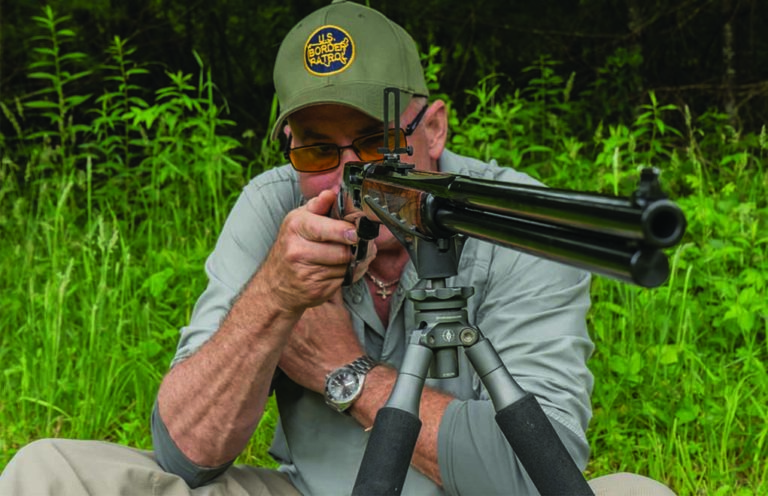
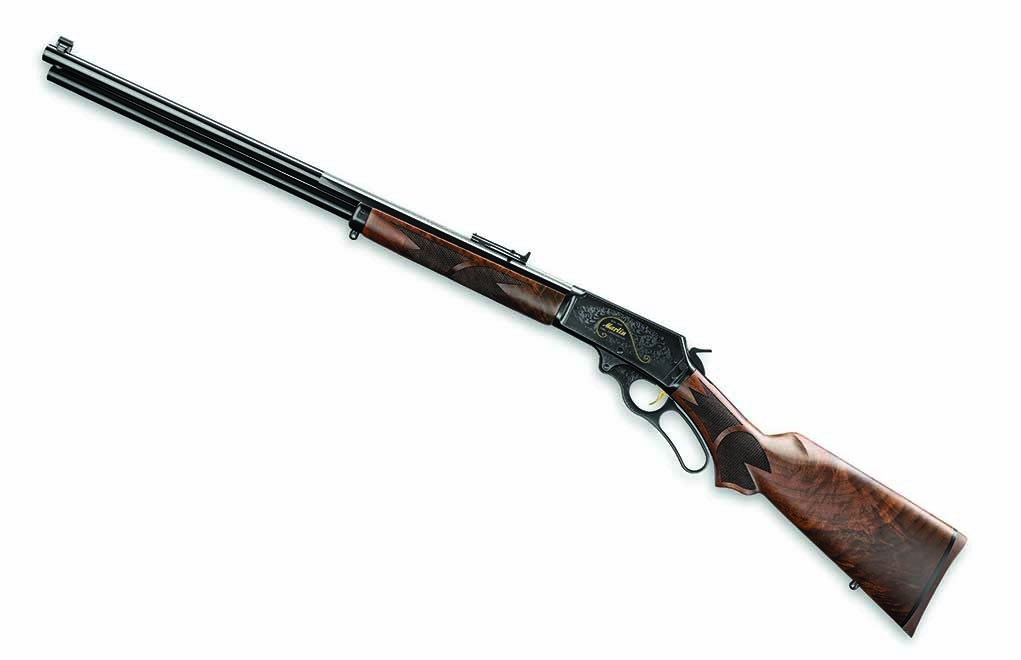
Open sights, pitching .444 Marlin from an 150th Anniversary Marlin Model 336, can you hit a country mile? Certainly, but doing so tells us something about the setup.
What Are The Challenges Of Connection Long With A .444 Marlin:
- The load used is a 265-grain FP Superformance with an advertised velocity of 2,400 fps.
- Zeroed at 100 yards, the bullet drops 8 inches at 200 yards and 6 feet at 400.
- A 10 mph, 90-degree crosswind, the bullet will drift about 2 inches at 100 yards and 4 feet at 400.
With nothing more than a 150th Annivesery Marlin Model 336 and steady nerves, you can make hits a country mile with the behemoth .444 Marlin.
For most of the past century, the lever gun was considered a short-range weapon. That wasn’t always the case. When the .30-30 Winchester cartridge was introduced in the 1894 Winchester, it provided much more reach than most lever guns of that age. Of course, it wasn’t long until we had cartridges such as the .30-06 in bolt-action rifles, and “long range” suddenly become a lot farther than it had ever been.
Now, it’s true that lever guns such as the Savage 99, Browning BLR and, most recently, the Henry Long Ranger, have been chambered for modern, flat-shooting cartridges such as the .308 Winchester and even 6.5 Creedmoor. But, these rifles are not traditional lever guns. It’s also true that in 1982, Winchester introduced the .307 Winchester in the Model 94; and, in 2007, Marlin unleashed the .308 Marlin Express. Both offered very improved ballistics over traditional lever-gun cartridges. Ultimately, no one seemed to give a damn: Both cartridges died on the vine.
That begs the question of what a traditional long-range lever gun might be like—as well as if you had one, what you might be able to do with it.
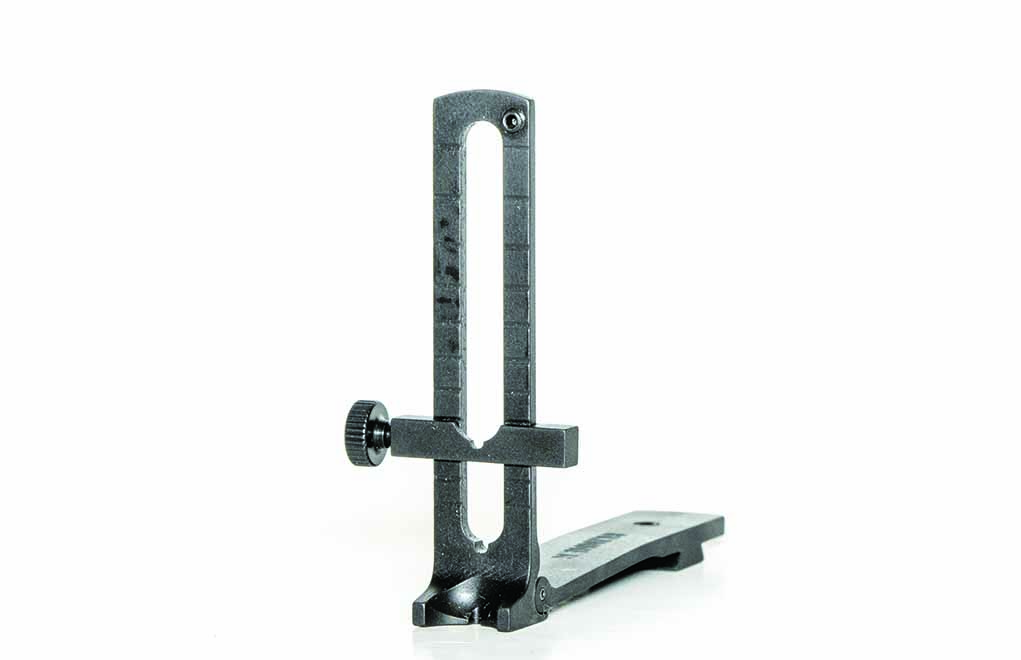
For 2020, Marlin introduced its 150th Anniversary rifle, which is built on the 336 action and is chambered for the .444 Marlin. It has a 24-inch, half-octagonal barrel, checkered, C-grade, American black walnut wood, some tasteful engraving and a gold inlay. It’s a gorgeous, well-made rifle that also comes with something else that would lead you to believe it is, indeed, a beautiful, well-made long-range rifle.
This limited-edition Marlin is fitted with a tangent sight from Skinner Sights. In addition to the standard buckhorn rear blade, a graduated rail with a sliding rear blade can be flipped up so you’re able to shoot at greater distances. This graduated rail is not marked in yardage; it’s marked for reference.
What I wanted to know is how effective this rifle could be at distance.
.444 Marlin Ballistic Facts
The flattest-shooting .444 Marlin load is probably the 265-grain FP Superformance load from Hornady. It has an advertised muzzle velocity of 2,400 fps. If it achieves that, zeroed at 100 yards, the bullet will drop about 8 inches at 200 yards, 30 inches at 300 and 6 feet at 400. Additionally, in a 10 mph, 90-degree crosswind, the bullet will drift about 2 inches at 100 yards, 10 at 200 yards, 2 feet at 300 and 4 feet at 400. This is ballistic fact—at least giving or taking an inch or so, depending on the ballistic calculator you use to do your guessing.
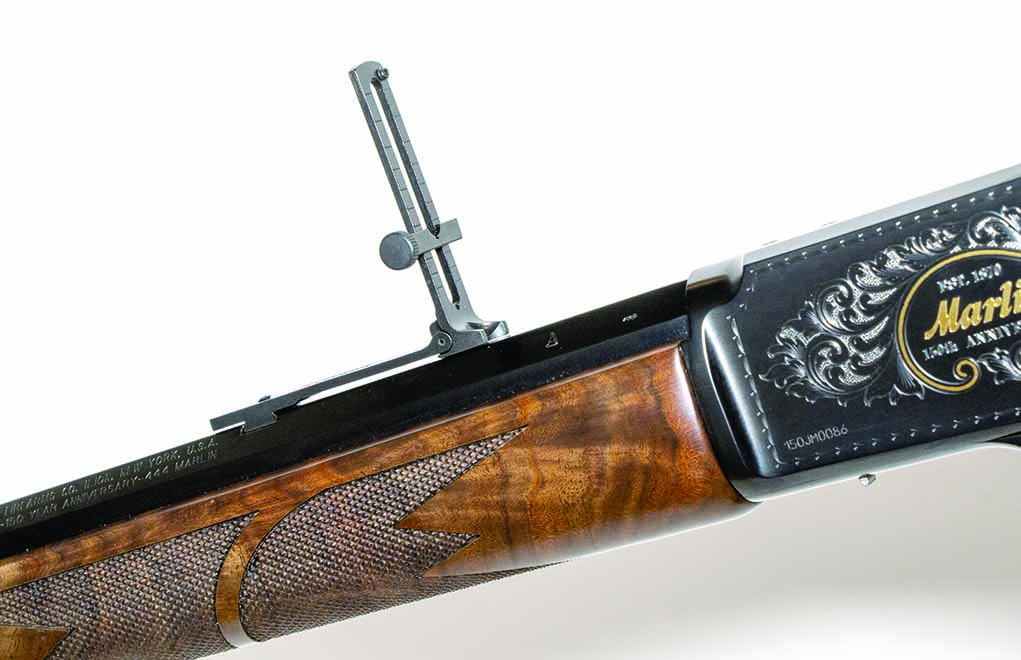
If you know this to be fact because you’ve confirmed it on the range, and if you have one of the twisty turret scopes to dial in an elevation and windage correction, you should be able to get hits from 100 yards all the way out to 400 yards. But, being able to dial in a ballistic solution isn’t the only consideration. For starters, what kind of fool wants to put a long-range rifle scope on a rifle such as this exquisite Marlin?
Speaking of traditional lever guns, I must quote Ashley Emerson, one of the founders of XS Sights. Ashley was fond of saying, “A man will go to hell if he puts a scope on a lever gun.”
Now, I don’t fully agree with that opinion; I can think of several reasons to put a scope on a lever gun. The most prominent is poor eyesight. If you like hunting with a lever gun, why should you have to give it up because of poor eyesight? Another is, of course, a scout scope, which doesn’t detract as much from the handling qualities of a good lever-action rifle.
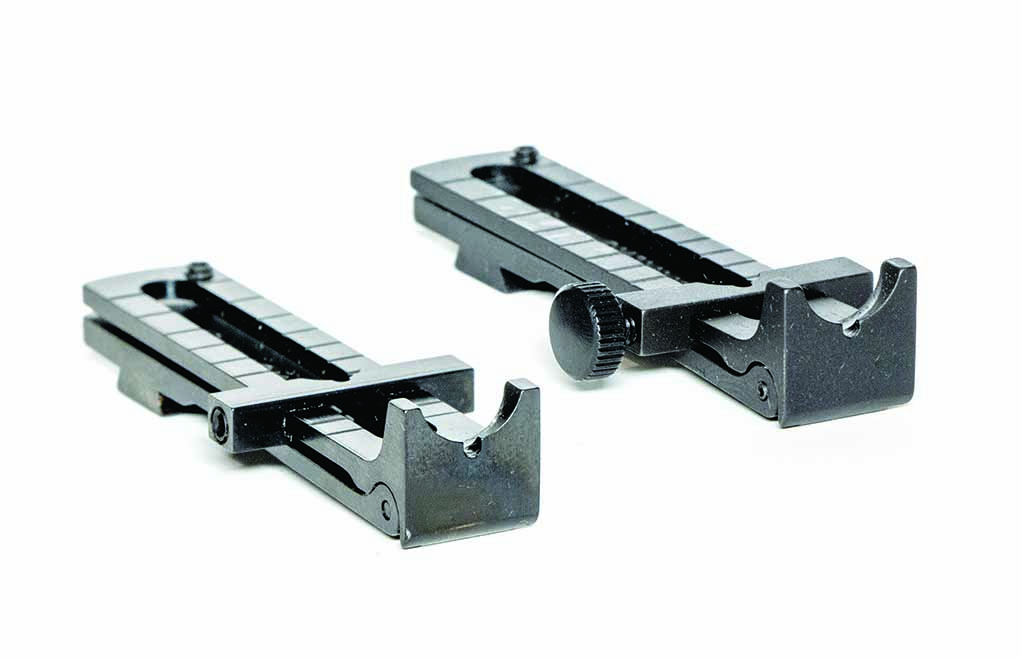
The other consideration has more to do with practicality than aesthetics; it has to do with range.
Let’s say you’re capable of hitting targets out to 400 yards with a scoped, traditionally styled lever gun because you know your data (or “DOPE,” as the long-range gurus like to call it). If you range a deer at 375—but it’s actually 350 (because you ranged the rock behind the deer)—when you input the elevation correction for 375 yards, your bullet will actually strike about a foot higher than your point of aim.
This is the curse of projectiles with poor aerodynamics: A slight mistake in range estimation equates to a miss. This applies to much-flatter-shooting cartridges too, but at much greater distances. To see a 10-inch variation in trajectory over a distance of 25 yards with a .308 Winchester, you’d have to be shooting at about 500 yards.
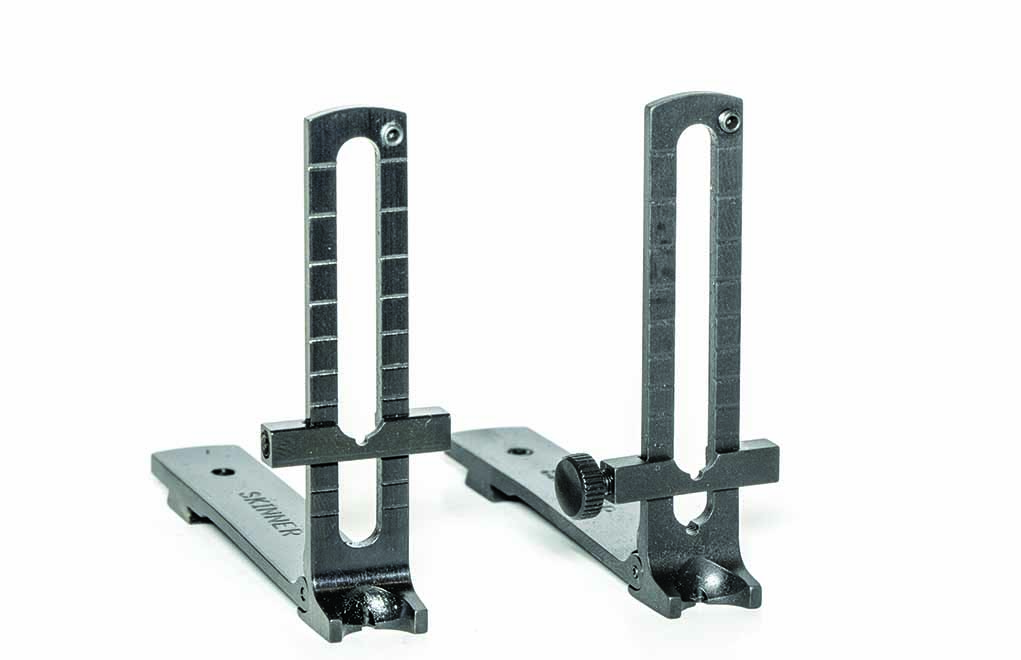
The final problem is wind. At 10 mph, a 90-degree crosswind will push the referenced .444 Marlin bullet more than 2 feet at 300 yards. Again, with the .308 Winchester, you’ll have to be shooting at about 500 yards to experience the same drift. It’s possible that from your shooting position there’s no wind, but that on the 300-yard journey to the target, the bullet could encounter a steady wind or gust. This could push the slow-moving bullet off course enough to cause at best, a miss and, at worst, a bad hit on an animal.
But, that’s enough ballistic speculation for one article. Let’s look at what I was actually capable of doing with this new Marlin at distance.
Get The Skinny On Marlin Guns:
- Marlin Model 336: Still A Hunting-Season Classic
- 7 Marlin Lever-Action Rifles Worth Adding To Your Collection
- Original Marlin Papoose is One Great Gun
- Marlin Firearms, Defining American Pride in Craftsmanship
- Marlin Firearms Values
The True Test
Shooting from a seated position with sticks for support, very much as you might do while hunting, my first three-shot group at 100 yards measured under 2 inches. That’s not too shabby, considering the sights on this rifle are a bit coarse and that the eyes looking across them had to be behind corrective lenses to even see them. More practically, I was able to hit an 8-inch steel plate every time at that distance.
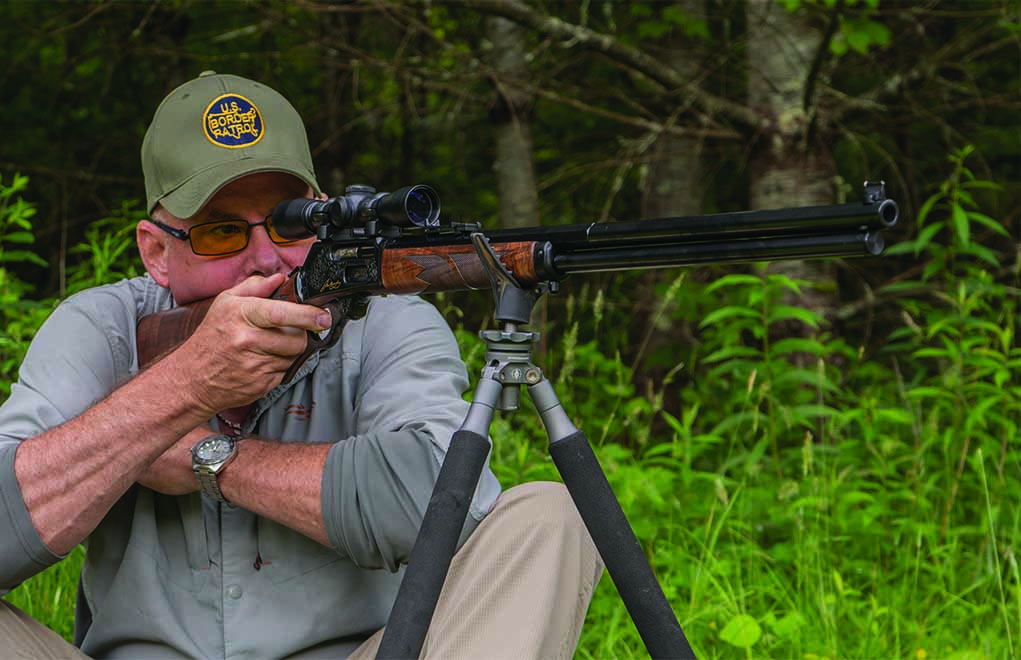
At 200 yards, things got a bit complicated, because when I flipped up the tangent sight and slid the sight blade to the very bottom, I found that the bullets were passing about 2 feet over the 200-yard target. The problem was that the sliding sight blade wasn’t regulated for 200 yards. Fortunately, there was some space below the lowest setting that allowed me to see through the slot. I placed the front bead in the center of this “U” and tried again. The bullet impacted about 4 inches above the plate. Holding at the bottom of the 16-inch plate, I was able to get three hits in a row.
I considered that respectable for open sights at 200 yards, but I was a bit disappointed in the settings/configuration of the tangent sight. The sight is made for Marlin by Skinner Sights, so I reached out to Andy Larsson at Skinner to discuss this. He said Marlin didn’t provide him with a rifle to build the sight to, so the company had to guess. I suggested he cut a notch in the bottom of the channel to use at 200 yards. Agreeing this was a good idea, he altered one and sent it to me.
Installed and zeroed, it was almost perfect at 200 yards. Again, firing from the seated position with shooting sticks, I shot a similarly sized good group on the 16-inch plate. Problem solved!
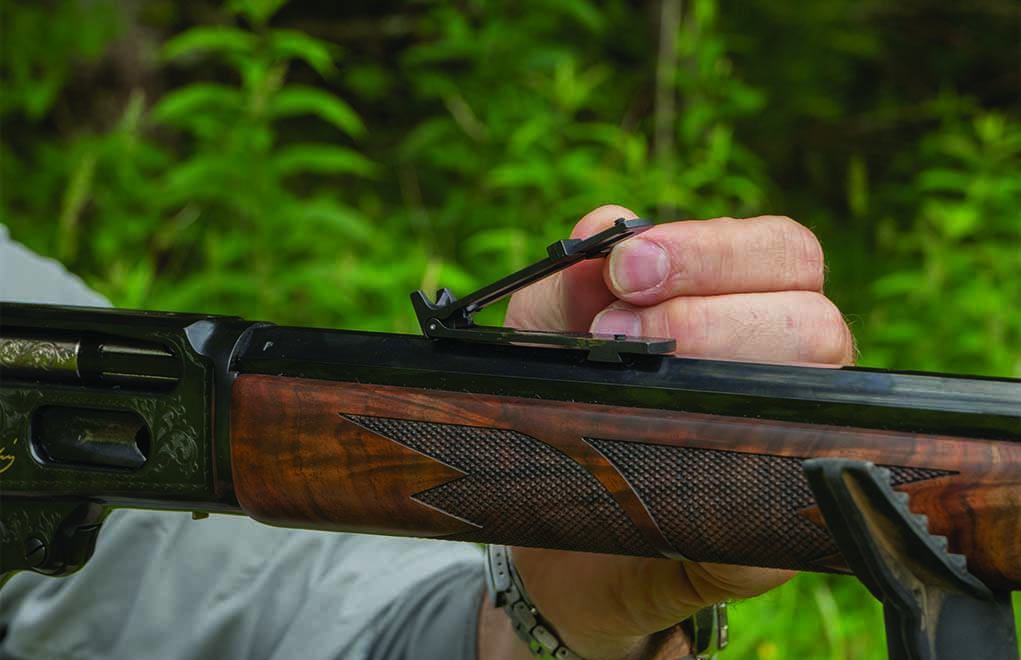
I’m not sure I could hit a deer at 200 yards in a natural setting every time, because they’re much harder to see than a white steel plate. But I can, for damned sure, “kill” a white, 16-inch steel plate at that distance. (In the interest of full disclosure, out of a subsequent string of 10 shots, I missed the plate three times.)
Reality being what it is, advertised ballistics are rarely achieved. Out of the Anniversary Marlin, the Hornady load averaged 2,313 fps. That’s 70 fps fewer than advertised and equates to an increase in drop of 3 inches at 300 yards. At 300 yards, I was already dealing with about 30 inches of drop, and a 16-inch steel plate looks pretty damned small at that distance. When I tried to put that 1/10-inch front bead on it, the plate disappeared. As you might surmise, this greatly complicates the process of aiming.
Fortunately, with the slider sight blade at the lowest setting, a 6 o’clock hold was needed to hit the steel. This allowed me to see the target, but the distance was pushing the limits of my prescription shooting glasses. Out of a string of 10 shots, I managed four hits. I think the rifle is capable of putting all the shots at 300 yards on a 16-inch, and even an 8-inch, plate, but my eyes and I weren’t.
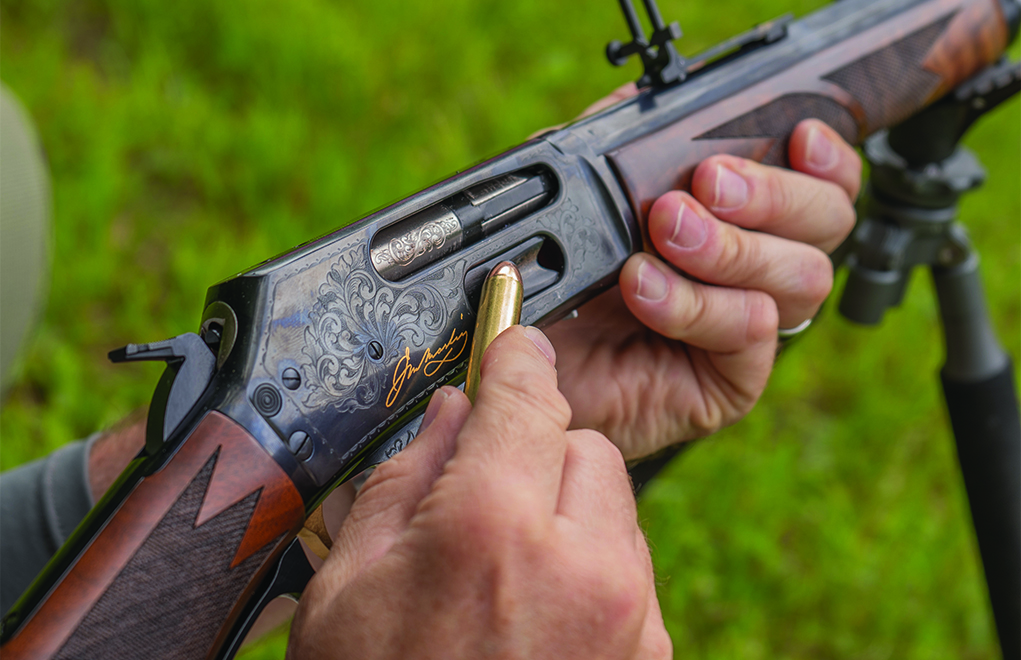
I didn’t see the point of attempting 400 yards. This is partly because it’s past the limits of my vision; partly because I didn’t have a steel plate any larger than 16 inches; but mostly because I could barely hit the damned thing at 300 yards. However, what I did do was switch to a riflescope. I have a discontinued super-compact Weaver 6X28mm riflescope that fits wonderfully on lever guns. I attached it, zeroed it and, from a bench rest at 100 yards, fired a three-shot group that measured 1.27 inches, center to center. The Anniversary Marlin will shoot.
After establishing a holdover point, at 200 yards, I rang the 16-inch steel 10 out of 10 times, and the best string of three shots grouped into a nice, little, 3-inch cluster. And yes, this was shooting from the seated position with sticks. At 300 yards, it took several shots to figure out my reference point on the reticle. (Sure, I could have clicked-in the correction, but I was trying to avoid that. That just seemed like a sacrilegious thing to do with a lever gun!) After I figured it out, I hit the steel seven out of 10 times.
Lessons Learned
There were several important takeaways from this experiment.
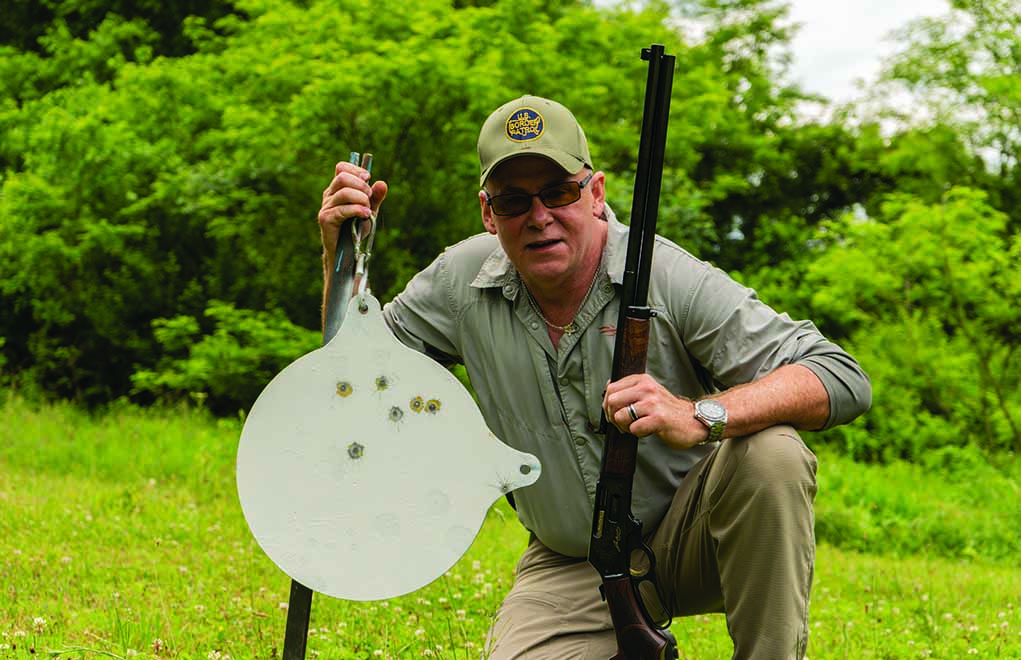
The first is that, practically speaking, an open-sighted lever gun chambered for a traditional lever-gun cartridge such as the .444 Marlin has a practical, open-sighted maximum hunting range of about 300 yards. Target sights could extend this distance, at least in non-hunting situations. The neat tangent sight from Skinner looks really cool and works, especially the modified version. However, while you might sometimes get some hits at stupid-long distances, it doesn’t present an ethical answer for hunting past 300 yards.
The second takeaway is that the 150th Anniversary Marlin rifle shoots every bit as good as it looks. Although most people will likely put it up as a collector, if you’re going to get serious about shooting with it at distance, I’d suggest you order the modified version of the Skinner sight and possibly a replacement front sight—one that has a slightly smaller bead so you can see the target you’re shooting at—for when you’re shooting a long way out there.
The third takeaway is that while Ashley Emerson might believe you’re doomed to perpetual brimstone if you put a riflescope on a lever gun, there’s no question that it’ll help you shoot with better precision. It’s not that it makes the rifle shoot better or more accurately; it’s just that it makes what you’re shooting at easier to see. And, well, that’s always a good thing. It’s damned hard to hit stuff you can’t see.
Still, I won’t be putting a scope on this rifle. It was never meant to have one. In addition, I think that given good lighting conditions, I could make a solid hit on a deer or similarly sized critter out to about 200 yards. Ballistically, that’s about the limit of this cartridge anyway. If I need to shoot farther, I have several optically sighted .308s.
For more information on the 150th Anniversery Marlin Model 336, please visit marlinfirearms.com.
Editor's Note: This article originally appeared in the August 2020 issue of Gun Digest the Magazine.

Next Step: Get your FREE Printable Target Pack
Enhance your shooting precision with our 62 MOA Targets, perfect for rifles and handguns. Crafted in collaboration with Storm Tactical for accuracy and versatility.
Subscribe to the Gun Digest email newsletter and get your downloadable target pack sent straight to your inbox. Stay updated with the latest firearms info in the industry.

![Best Concealed Carry Guns In 2025 [Field Tested] Wilson Combat EDC X9S 1](https://gundigest.com/wp-content/uploads/Wilson-Combat-EDC-X9S-1-324x160.jpg)


![Best 9mm Carbine: Affordable PCCs [Tested] Ruger Carbine Shooting](https://gundigest.com/wp-content/uploads/Ruger-Carbine-Shooting-100x70.jpg)
![Best AR-15: Top Options Available Today [Field Tested] Harrington and Richardson PSA XM177E2 feature](https://gundigest.com/wp-content/uploads/Harrington-and-Richardson-PSA-XM177E2-feature-100x70.jpg)

You kind of gave short shrift to the obvious answer……a tang or receiver mounted peep sight. A Marble’s tang sight with click adj. windage and elevation or maybe a receiver mounted Lyman 66 with click adjustment target knobs, perhaps with a spare bridge with Hunter click adjustments since they don’t lose zero when removed. A adjustable peep insert with an adjustable iris would be nice as well. While the Skinner sights would be pretty Good out to 150 beyond that your hit percentage would probably go up considerably with a good peep. With no need for a Scope!
Very Good Story by the way.